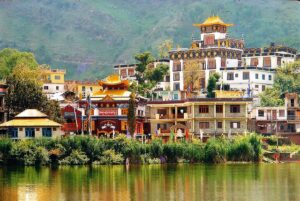
Rewalsar is a small town and a nagar panchayat in Mandi district Himachal Pradesh. At its heart lies the holy lake that is home to three Hindu Temples, a Sikh Gurudwara and three Buddhist Monasteries. One of the local names for Rewalsar is Trisangam (Three Holy Communities) and as such it serves as a fine example of religious tolerance and harmony that makes India great.
Seven lakes associated with the Pandavas of Mahabharata are located above Rewalsar. Also associated with Rewalsar are the legends of Lord Shiva and Lomas Rishi. There is also a famous Krishna temple in the town.
The Hindu history of Rewalsar is found in Skanda Purana. A Hindu sage named Lomas was searching for place to worship. He travelled and climbed the top of Drona mountain, from the top of mountain he saw a beautiful lake surrounded by beautiful trees, flowers and birds. He decided to meditate at the bank of the lake, written as Hridyaleshwar in Skanda Purana. He meditated here, and Lord Shiva and Goddesses Parvati blessed him by imparting the secrets of this place where all the Devas and Ganas are in the form of flowers, and trees.
The Tibetan and Himachali Buddhists call Rewalsar Tso Pema (Lotus Lake) in honour of the Padmasambhava who lived and meditated here. A 12m statue of Padmasambhava has been erected on the hillside above the lake, a sight that dominates the landscape as you enter the town.
The master is supposed to have flown to Tibet from this holy land by virtue of his supernatural powers to spread ‘Dhamma or Dharma’ and to propagate ‘Mahayana Buddhism’ in Tibet where he is regarded as second Buddha and is known as Guru Rimpoche. It is said that when he came to this land to preach the holy word of Buddhism, the King of this place ignorantly ordered to burn him alive at the very site of Rewalsar after hearing some rumours about the master.
But to his surprise, the flames of the pyre turned into a deep beautiful lake and there emerged the master unaffected sitting onto a lotus flower in the middle of the lake. Realizing the master’s powers, King apologised for his act and devoted rest of his life to the sublime teachings of ‘Dhamma’. It is still believed that the master’s spirit rests in the island of floating reeds on the lake.
Rewalsar is home to quite a few monasteries that belong to Nyingmpa sect. Of special mention are Drikung Kagyud Gompa, Tso-Pema Ogyen Heru-kai Nyingmapa Gompa and the Zigar Gompa.
The gompas, in red, yellow and white, have gold fringed pagodas. Other highlights of the monasteries include murals depicting a wonderful amalgamation of the Indo Chinese style and a huge stucco image of Guru Padmasambhava. The Tso-Pema Ogyen Heru-kai Nyingmapa Gompa has a museum with colourful murals.
Guru Gobind Singh visited Rewalsar to seek support from kings of the Hill states for a joint resistanace against Aurangzeb. Raja Joginder Sen of Mandi built a gurudwara at Rewalsar in 1930 to commemorate the Guru’s visit. The place is particularly sacred to Namdhari Sikhs since Rewalsar is mentioned in Sau Sakhi as a sanctuary.
Fairs
Rewalsar shrugs off its calm in February-March with the Sisu Fair, the Buddhist equivalent of the Kumbh Mela. During Baisakhi, pilgrims come here to light lamps and offer prayers at the Lomas Rishi Temple.
Source:
https://www.ghumakkar.com/rewalsar-a-sacred-confluence-of-multi-religions/ pics
http://www.buddhist-tourism.com/countries/india/monasteries/himachalpradesh/rewalsar-monastery.html
https://en.wikipedia.org/wiki/Rewalsar,_India
https://www.outlookindia.com/outlooktraveller/ot-getaway-guides/rewalsar-lotus-lake/


